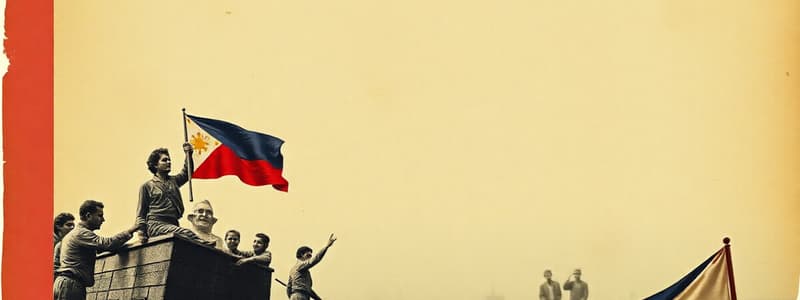Podcast
Questions and Answers
What primary influence shaped Filipino nationalism in the 19th century?
What primary influence shaped Filipino nationalism in the 19th century?
- The decline of Spanish colonial power in Asia
- Exposure to Western ideas and the growth of a literate class (correct)
- The isolation of the Filipino islands from other nations
- Direct military conflict with Spain
Which of the following was a significant outcome of over 300 years of Spanish colonial rule?
Which of the following was a significant outcome of over 300 years of Spanish colonial rule?
- Enhanced economic opportunities for Filipinos
- The establishment of a hierarchical social system (correct)
- Immediate independence following the colonial period
- Complete cultural autonomy for indigenous groups
How did Spanish colonial rule impact the cultural expression of Filipinos?
How did Spanish colonial rule impact the cultural expression of Filipinos?
- It resulted in the development of new regional art forms
- It allowed for the preservation of Indigenous traditions
- It suppressed cultural expression altogether (correct)
- It encouraged the fusion of Filipino and Spanish cultures
Which notable figure is associated with the rise of Filipino nationalism in the 19th century?
Which notable figure is associated with the rise of Filipino nationalism in the 19th century?
What characterized the period of Spanish colonialism in the Philippines?
What characterized the period of Spanish colonialism in the Philippines?
What was the main reason Rizal became a symbol of Filipino resistance?
What was the main reason Rizal became a symbol of Filipino resistance?
What group did Andres Bonifacio lead during the Philippine Revolution?
What group did Andres Bonifacio lead during the Philippine Revolution?
What inspired the Filipino revolutionaries in their fight against Spanish rule?
What inspired the Filipino revolutionaries in their fight against Spanish rule?
When was Philippine independence declared?
When was Philippine independence declared?
What event led to the cession of the Philippines from Spain to the United States?
What event led to the cession of the Philippines from Spain to the United States?
Flashcards
Spanish Colonialism in the Philippines
Spanish Colonialism in the Philippines
The period when Spain ruled the Philippines, lasting for more than three centuries (16th to 19th century). It brought cultural exchange, Catholicism, and a social hierarchy but also imposed strict control on Filipinos.
Rise of Filipino Nationalism
Rise of Filipino Nationalism
The awakening of Filipino identity and desire for independence, spurred by exposure to Western ideas, growing literacy, and examples of other nations gaining freedom.
Who was Jose Rizal?
Who was Jose Rizal?
A key figure in the Philippine nationalist movement, known for his writings that exposed the injustices of Spanish rule and called for reform.
Who was Andres Bonifacio?
Who was Andres Bonifacio?
Signup and view all the flashcards
American Occupation of the Philippines
American Occupation of the Philippines
Signup and view all the flashcards
What was the Katipunan?
What was the Katipunan?
Signup and view all the flashcards
What was the Philippine Revolution?
What was the Philippine Revolution?
Signup and view all the flashcards
How did Jose Rizal contribute to the nationalist movement?
How did Jose Rizal contribute to the nationalist movement?
Signup and view all the flashcards
When did the Philippines declare its independence?
When did the Philippines declare its independence?
Signup and view all the flashcards
What happened after the Philippines declared its independence?
What happened after the Philippines declared its independence?
Signup and view all the flashcards
Study Notes
Philippines Independence
- The Philippines' journey to independence involved resilience, nationalism, and a strong desire for self-determination.
- Spanish colonization lasted over 300 years (16th to 19th centuries), marked by significant cultural exchange (including the spread of Catholicism) and a hierarchical social structure.
- Spanish colonial rule also involved strict control over Filipinos, limiting their cultural expression and economic opportunities.
Rise of Filipino Nationalism
- The 19th century saw the emergence of Filipino nationalism, influenced by Western ideas, a growing literate class, and the examples of other independent nations.
- Key figures such as Jose Rizal, Marcelo H. del Pilar, and Andres Bonifacio played crucial roles in the nationalist movement.
- Rizal's novels, "Noli Me Tangere" and "El Filibusterismo," criticized Spanish rule and called for reforms.
The Philippine Revolution
- Inspired by the French Revolution and the American War for Independence, Filipinos launched an uprising (1896) against Spanish rule.
- Andres Bonifacio and the Katipunan (a secret society) led the armed resistance.
- The revolution, despite initial setbacks, gained momentum and led to a declaration of Philippine independence on June 12, 1898.
American Occupation
- The Spanish-American War (1898) resulted in Spain ceding the Philippines to the United States.
- Initial American support for Filipino independence shifted to establishing colonial control.
- This led to the Philippine-American War (1899-1902), another period of conflict.
Road to Independence
- Filipinos continued to fight for self-determination despite American occupation.
- Peaceful protests, political activism, and education helped build a case for independence.
- The Jones Act of 1916 granted greater autonomy to the Philippines.
Full Independence
- Finally, on July 4, 1946, the Philippines gained full independence from the United States and became a sovereign republic.
Studying That Suits You
Use AI to generate personalized quizzes and flashcards to suit your learning preferences.




